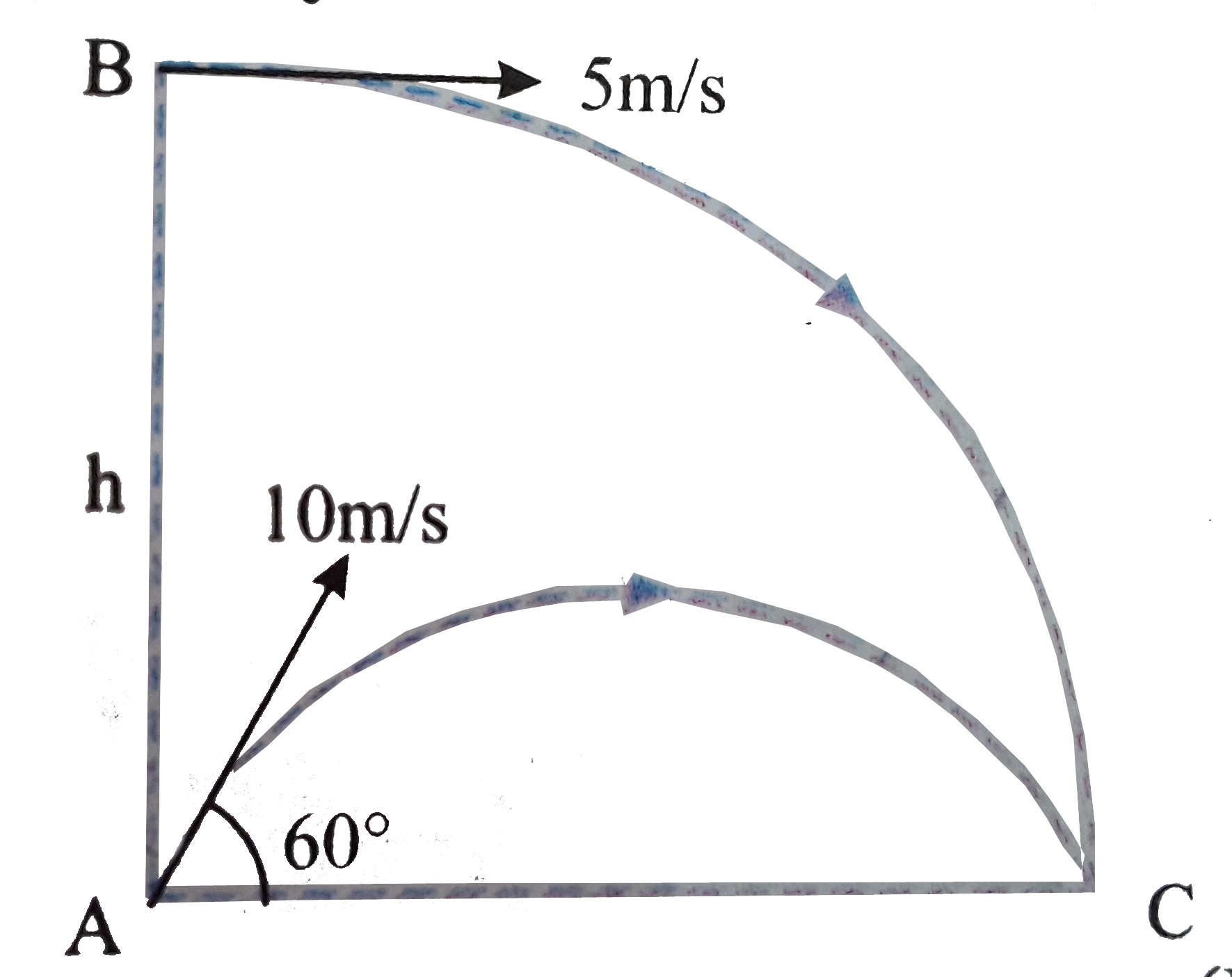A particle is projected from ground with an initial velocity 20m/sec making an angle 60∘ with horizontal . If R1 and R2 are radius of curvatures of the particle at point of projection and highest point respectively, then find the value of R1R2.
The correct Answer is:8
To solve the problem, we need to find the ratio of the radii of curvature R1 and R2 at the point of projection and at the highest point of the projectile motion, respectively.
Step 1: Identify the given data
- Initial velocity V0=20m/s
- Angle of projection θ=60∘
- Acceleration due to gravity g=9.8m/s2 (we can use g as 9.81m/s2 for more precision, but it won't affect the ratio)
Step 2: Calculate the radius of curvature at the point of projection R1
At the point of projection, the velocity V is V0. The components of gravitational acceleration are:
- gcosθ (perpendicular to the velocity)
- gsinθ (along the direction of velocity)
The radius of curvature R1 is given by the formula:
R1=V20gcosθ
Substituting the values:
R1=(20)2gcos(60∘)
Since cos(60∘)=12:
R1=400g⋅12=800g
Step 3: Calculate the radius of curvature at the highest point R2
At the highest point, the horizontal component of the velocity is:
V=V0cosθ
Thus,
V=20⋅cos(60∘)=20⋅12=10m/s
The radius of curvature R2 at the highest point is given by:
R2=(V0cosθ)2g
Substituting the values:
R2=(10)2g=100g
Step 4: Find the ratio R1R2
Now we can find the ratio of the two radii of curvature:
R1R2=800g100g=800100=8
Final Answer
Thus, the value of R1R2=8.
---
- Initial velocity V0=20m/s
- Angle of projection θ=60∘
- Acceleration due to gravity g=9.8m/s2 (we can use g as 9.81m/s2 for more precision, but it won't affect the ratio)
At the point of projection, the velocity V is V0. The components of gravitational acceleration are:
- gcosθ (perpendicular to the velocity)
- gsinθ (along the direction of velocity)
R1=V20gcosθ
R1=(20)2gcos(60∘)
Since cos(60∘)=12:
R1=400g⋅12=800g
At the highest point, the horizontal component of the velocity is:
V=V0cosθ
Thus,
V=20⋅cos(60∘)=20⋅12=10m/s
R2=(V0cosθ)2g
Substituting the values:
R2=(10)2g=100g
Now we can find the ratio of the two radii of curvature:
R1R2=800g100g=800100=8
Thus, the value of R1R2=8.
Topper's Solved these Questions
- BOOK - RESONANCE ENGLISHCHAPTER - DAILY PRACTICE PROBLEMSEXERCISE - dpp 755videos
DAILY PRACTICE PROBLEMS
- BOOK - RESONANCE ENGLISHCHAPTER - DAILY PRACTICE PROBLEMSEXERCISE - dpp 765videos
DAILY PRACTICE PROBLEMS
- BOOK - RESONANCE ENGLISHCHAPTER - DAILY PRACTICE PROBLEMSEXERCISE - dpp734videos
DAILY PRACTICE PROBLEMS
- BOOK - RESONANCE ENGLISHCHAPTER - CURRENT ELECTRICITYEXERCISE - Exercise53videos
CURRENT ELECTRICITY
- BOOK - RESONANCE ENGLISHCHAPTER - ELASTICITY AND VISCOCITYEXERCISE - Advanced Level Problems9videos
ELASTICITY AND VISCOCITY
Similar Questions
Knowledge Check
- Question 1 - Select One
A particle is projected from the ground with an initial speed v at an angle θ with horizontal. The average velocity of the particle between its point of projection and highest point of trajectory is [EAM2013]
AucosθBu2√1+cos2θCu2√1+2cos2θDu2√1+3cos2θ
A ball of mass m is projected from the ground with an initial velocity u making an angle of θ with the vertical. What is the change in velocity between the point of projection and the highest point ?
View SolutionA particle of mass 1kg has been thrown with initial speed 20 ms making an angle 60° with the horizontal ground. the angular momentum of the particle about point of projection when the projectile is at highest point is (g=10m/s^2)
View SolutionA particle of mass m=1kg is projected with speed u=20√2m/s at angle θ=45∘ with horizontal find the torque of the weight of the particle about the point of projection when the particle is at the highest point.
View SolutionA particle is projected from ground at an angle θ with horizontal with speed u. The ratio of radius of curvature of its trajectory at point of projection to radius of curvature at maximum height is -
View SolutionA particle is projected with a velocity 10 m//s at an angle 37∘ to the horizontal. Find the location at which the particle is at a height 1 m from point of projection.
View SolutionA particle is projected with velocity 20ms−1 at angle 60∘ with horizontal . The radius of curvature of trajectory , at the instant when velocity of projectile become perpendicular to velocity of projection is , (g=10ms−1)
View SolutionA particle A is projected from the ground with an initial velocity of 10m/s at an angle of 60∘ with horizontal. From what height should an another particle B be projected horizontally with velocity 5m/s so that both the particles collide in ground at point C if both are projected simultaneously g=10m/s2.
 View Solution
View Solution

